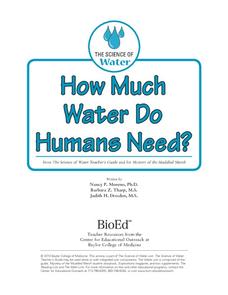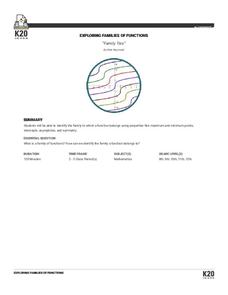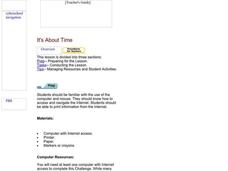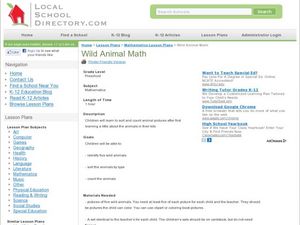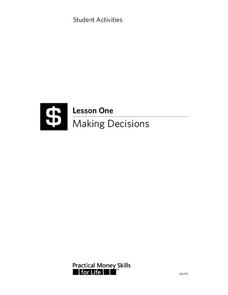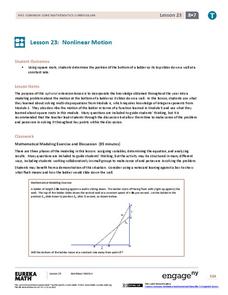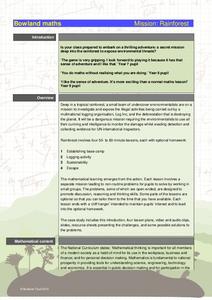Baylor College
How Much Water Do Humans Need?
Physical or life science learners measure the amounts of water eliminated by intestines and the urinary system, and the amounts lost via respiration and perspiration. In doing so, they discover that the body's water must be replenished...
Mascil Project
Parachute Food Drop
Drop a perfect project into your lesson plans. Groups use different building materials to create models of parachutes for food drops. After testing out their prototypes, they make improvements to their designs.
Facebook
Social Media and Sharing
Whether it's cute cat videos or pictures from an epic vacation, scholars love to check out what's happening on social media! But, how much sharing is too much? A lesson from a vast digital citizenship series poses some serious points to...
West Contra Costa Unified School District
Arcs and Angles
Noah didn't construct this kind of arc. High school scholars first explore how angles can be formed in circles. They then learn relationships between angles and arcs by conducting an exploratory activity where they position and draw arcs...
K20 LEARN
Family Ties: Exploring Families OF Functions
They say it runs in the family. Small groups use a card sorting activity to group graphs of functions into families. After grouping by families, the class develops conclusions for parent functions and create a graphic organizer.
Curated OER
It's About Time: Olympics, Winter Sports, Math, Media, Time Zones
Students use the Internet to determine broadcast times for the Winter Olympic Games snowboarding competitions. In determining these times, they need to consider time zones throughout the world.
Curated OER
Lesson on economic value of education
Students use economic reasoning to analyze both the short-term and long-term benefits and opportunity costs of educational choices, identify incentives that may influence students' career decisions and solve an "economic mystery"
Curated OER
Stories That Really Add Up
Students, in groups, develop math lessons for younger students that each stems from a popular student story. Group members individually develop lessons for other subject areas based on their group's story, creating interdisciplinary units.
Curated OER
Telling Time
Students study telling time to minutes and hours. For this telling time lesson, students watch the teacher complete an example of telling how many minutes are in 120 minutes and how many hours are in 150 minutes. They answer 10 questions...
Curated OER
Wild Animal Math
Students examine wild animals. In this sorting and counting lesson, students are introduced to animals by viewing pictures. Students discuss the sounds they make, where they live and what they eat. Students pretend to be the animals....
Curated OER
Refrigerator to Renoir: Ten Great Art Lessons on the Net
Every learner can be an artist with a series of activities designed to access their creativity. With reference links and instructional ideas, this art resource is sure to enrich your class and bring new ideas to even your most reluctant...
Curated OER
Lesson 56
Sixth graders practice Least Common Multiple in fractions. In this fraction lesson, 6th graders look at two different fractions and find a common denominator. They sing a song to memorize mean, median, and mode.
Curated OER
Central Valley Math Project
Middle schoolers study the Pythagorean Theorem. They describe what it means to square a number. Pupilsuse the Pythagorean Theorem to prove the sides of given triangles, and use geometric pieces of paper to create a right triangle and...
EngageNY
Completing the Square (part 2)
Give classes confidence in completing the square with a resource that develops the process of completing the square of more complex problems, including fractions and values greater than one. It then uses quadratic modeling for...
Curated OER
Nutrition Lesson Plan
Third graders explore a variety of breakfast foods and beverages and write a creative story about their favorite. They then present their stories to the class and are encouraged to try different foods during the story time.
Visa
Making Decisions
What economic factors can influence personal and financial decisions? In an effort to understand opportunity costs and the time value of money, pupils engage in role-playing activities and discussion, as well as view a PowerPoint...
Curated OER
Lesson Plan fo The Magic Eyes of Little Crab
Interested in a "how and why" story to read with young students? In this storytelling activity, readers will discuss sea creatures, focusing on practicing new terminology through retelling the story. This resource provides a list of...
Illustrative Mathematics
Bike Race
A graph not only tells us who won the bike race, but also what happened during the race. Use this resource to help learners understand graphs. The commentary suggests waiting until the end of the year to introduce this topic, but why...
Illustrative Mathematics
Estimating Square Roots
No calculators! Assure your learners that they can find the square root of a large number. All they need are two known squares close by and a table. Come up with an additional practice and your number crunchers will have it mastered in...
101 Questions
Dollar Wall
Money doesn't grow on trees—it grows on walls. Using pictures of a Guggenheim art installation consisting of one-dollar bills glued to a wall, future mathematicians consider the monetary value of the bills used in the installation....
Curated OER
Parallel and Perpendicular Lines and Lines of Symmetry: Rhombus Shadowing
Fifth graders demonstrate different types of lines using movement. In this line and movement lesson, 5th graders demonstrate parallel and perpendicular lines, and lines of symmetry using dance movement. They also demonstrate rhombus...
BioEd Online
Good Stress for Your Body
Stress the importance of the different types of pressure our mind and body experience in a lesson about how certain types of stress are actually necessary and good for our bodies. As astronauts and people with injuries can attest, not...
EngageNY
Nonlinear Motion
Investigate nonlinear motion through an analysis using the Pythagorean Theorem. Pupils combine their algebraic and geometric skills in the 24th lesson of this 25-part module. Using the Pythagorean Theorem, scholars collect data on the...
Bowland
Mission: Rainforest
Young environmentally conscious mathematicians solve a variety of problems related to the central theme of uncovering illegal logging activities. They determine a base camp based on given constraints, investigate logging activities and...


